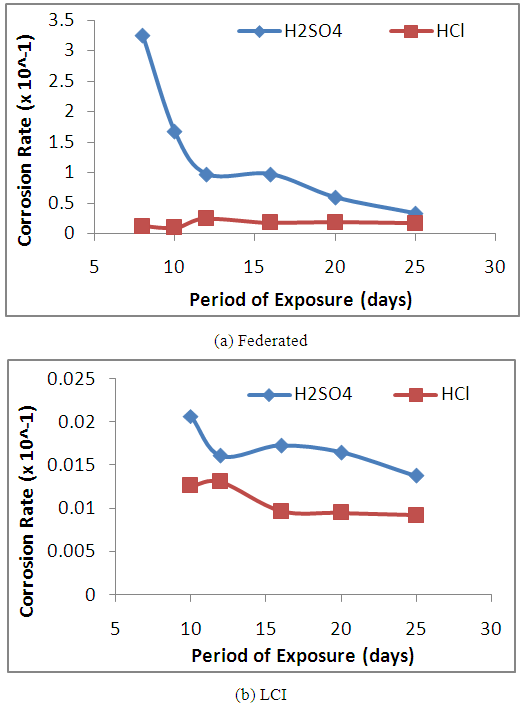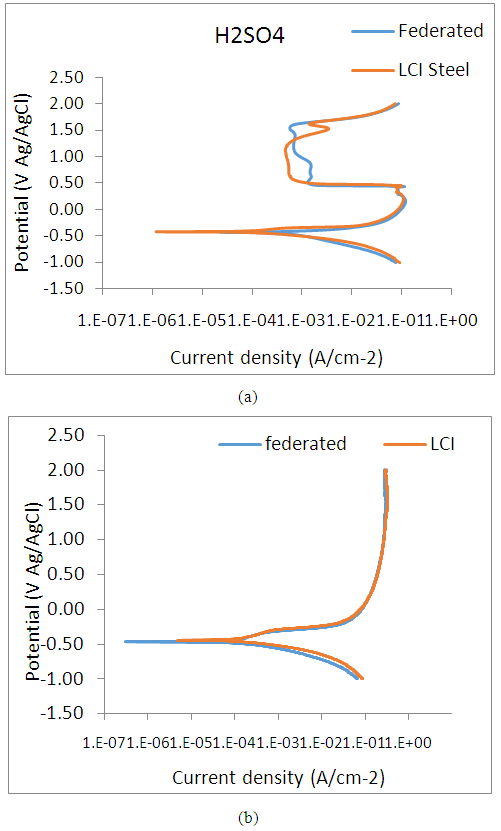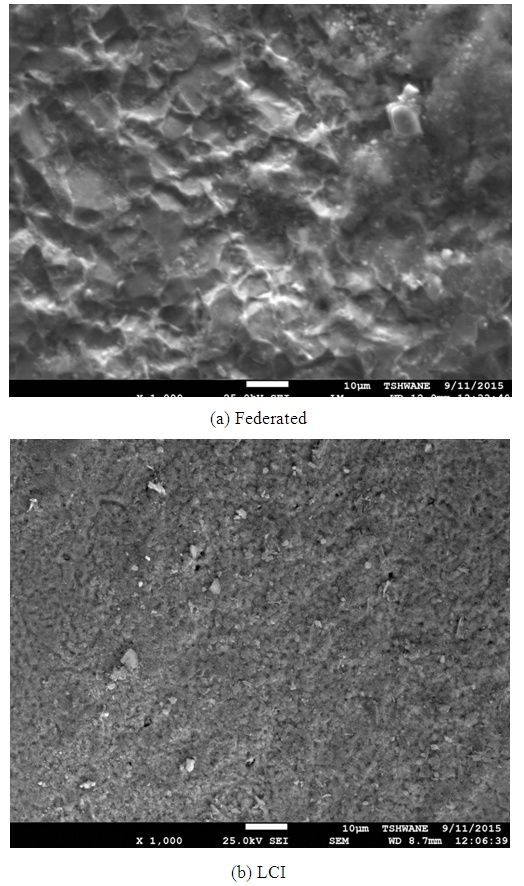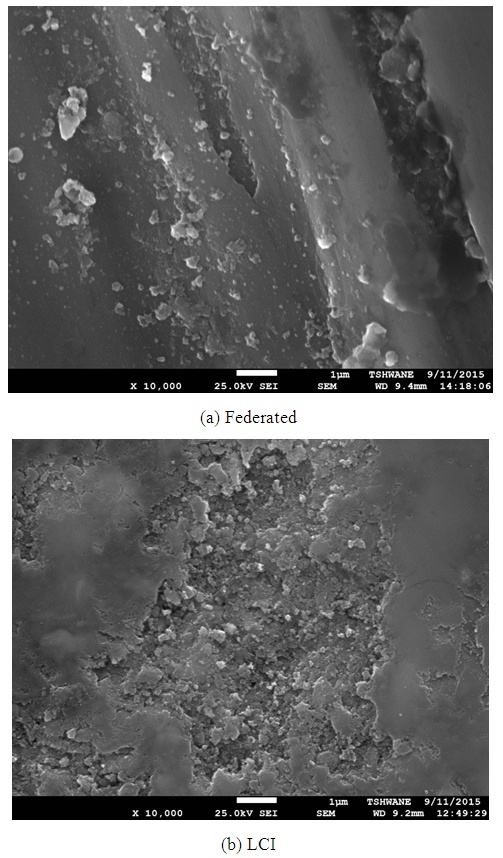-
Paper Information
- Paper Submission
-
Journal Information
- About This Journal
- Editorial Board
- Current Issue
- Archive
- Author Guidelines
- Contact Us
International Journal of Materials Engineering
p-ISSN: 2166-5389 e-ISSN: 2166-5400
2017; 7(4): 77-82
doi:10.5923/j.ijme.20170704.03

The Study of Wear and Corrosion Properties of Two Grades of Carbon Steel Used in Construction Industries in Nigeria
Alo F. I.1, Oluyamo S. S.2, Faromika O. P.2, P. O. Atanda1, A. A. Daniyan1, K. M. Oluwasegun1
1Materials Science and Engineering Department, Obafemi Awolowo University, Ile-Ife, Nigeria
2Condensed Matter & Statistical Physics Unit, Physics Department, Federal University of Technology, Akure, Nigeria
Correspondence to: Alo F. I., Materials Science and Engineering Department, Obafemi Awolowo University, Ile-Ife, Nigeria.
| Email: |  |
Copyright © 2017 Scientific & Academic Publishing. All Rights Reserved.
This work is licensed under the Creative Commons Attribution International License (CC BY).
http://creativecommons.org/licenses/by/4.0/

This study evaluated two grades of low carbon steel-the Federated steel and the Land Craft Industrial (LCI) steel with the aim of assessing their wear and corrosion behaviour in acidic media. The electrochemical characterization involved potentiodynamic scanning in 0.5 M for both HCL and H2SO4 solutions, while the wear measurements were determined under normal ranging from 10 N to 25 N at interval of 5 N incremental. The morphology of the corroded samples were carried out using optical microscopy and scanning electron microscopy (SEM). The results demonstrated that Federated steel had a lower corrosion rate in hydrochloric acid (HCL) medium than Land Craft Industrial steel. On the other hand, Land Craft Industrial steel had a low corrosion rate in H2SO4 medium compared with Federated steel. The corrosion wear coefficient (COF) of Federated steel had a good waveform compared to that of land craft industrial steel.
Keywords: Federated and Land Craft Steel, Electrochemical corrosion behaviour, Corrosion rate
Cite this paper: Alo F. I., Oluyamo S. S., Faromika O. P., P. O. Atanda, A. A. Daniyan, K. M. Oluwasegun, The Study of Wear and Corrosion Properties of Two Grades of Carbon Steel Used in Construction Industries in Nigeria, International Journal of Materials Engineering , Vol. 7 No. 4, 2017, pp. 77-82. doi: 10.5923/j.ijme.20170704.03.
Article Outline
1. Introduction
- The attendant incidence of building and construction failure/collapse in the country and across the globe calls for attention and studies on the cause in order to stem the tide especially the humans and material loss associated with such incidence. Almost all the steels produced in the country are low alloy steel and are mainly used in various environments, such as the atmosphere marine and soil. There is growing concern globally about the menace of corrosion and how to overcome this effect on low alloy steel. Carbon steel is highly susceptible to corrosion attack. Hence, structures made of steel like buildings, bridges, industrial plants, ships, aircrafts, pipeline, and drilling platforms. etc. are degraded in service by corrosion [1, 2]. It is on record that in modern industrialization and technological advancement, metals account for over 80% of equipment composition used for construction. It has been reported that about 42% of the 12 mm bars and 46% of 16 mm bars in Lagos State of Nigeria failed to meet the BS code prescription of 460 N/mm2 yield strength and about 28% and 33% of 12 mm and 16 mm bars respectively failed to meet the Nigeria professional prescription of 410 N/mm2 [3] but few papers have reported in the literature concerning the wear and corrosion studies of the steel under investigation.Among many failure modes associated with steel components, wear presents a unique challenge to the designer and the developer of mechanical components [4]. Traditionally, normal contact load and sliding speed are considered the most important parameters in tribological systems [5]. Surface roughness is a major problem during the production process and greatly affects the quality of the product [6]. Studies had shown that friction increases as the surface roughness of a material increases, and correlates inversely with the load [7]. Wear studies are found in almost all industrial sectors due to the relevance of surface failure, which can negatively alter the performance of industrial facilities, shorten their service life and compromised safety issues [8]. Chowdhury [9] observed that wear rate increases with the increases in normal load for all types of materials investigated. When the load on the pin is increased, the area of the contact would increase towards the nominal contact area. Thus, the increased frictional force and real surface area in contact causes higher wear. This means that the shear force and frictional thrust are increased with increase of applied load and this increase in values accelerates the wear rate. It had also been observed that wear rate increases with increase in normal load for mild steel-mild steel [10]. Increased surface roughening and a large quantity of wear debris is believed to be responsible for decrease in friction at higher loads [11, 12]. It was observed that the coefficient of friction may be very low for smooth surfaces and/or at loads down to micro-to-nanonewton range [13, 14].In this paper wear and corrosion properties of selected steel were investigated. The micro structures were analysed by Optical Microscope (OM), Scanning Electron Microscopy (SEM), CERT UMT -2 Tribology Machine and Autolab Potentiostat Galvanostat.
2. Experimental Procedures
- The experimental procedures were carried out as follows.
2.1. Materials and Sample Preparation
- The steels were commercially obtained and the chemical composition of the steels were analyzed at Nigerian Foundries Limited, Ilupeju, and Lagos State, Nigeria.The mild steels were sectioned into 30 mm × 20 mm × 5.0 mm and were successively grinded with a series of SiC abrasive papers (240, 320, 600 and 800). Thereafter, the samples were polished with emery cloth using 5 µm diamond paste, rinsed with ethanol, dried with ultrasonic dryer and stored.
2.2. Electrochemical Measurement
- The specimens with an exposed surface of 2 cm2 were used for the electrochemical experiment; the other sides were coated with an epoxy insulating material. Two different solutions which are H2SO4 and HCL were employed as the environment at the same concentration of 0.5 M. The electrochemical measurements were carried out with Autolab Potentiostat. The reference electrode used was silver/silver chloride in 3 M KCl, platinum was used as the counter electrode and the samples were the working electrode. The potentiodynamic scan was done at ± 0.5 V at a scan rate of 0.002001 V/S and the corrosion rates were determined using the following expression:
 | (1) |
2.3. Wear Measurement
- The samples wear performances were carried out on CERT-UMT-2 Tribology Machine (Bruker Nano Inc., Campbell, CA) which is a reciprocating – sliding friction test mode involving a ball-on-disc configuration. Figure 2 displayed the schematic diagram of the tribometer setup and the tests were performed according to Obadele et al., 2015. The tests involved reciprocating sliding with loads of 5, 15, and 25 N at a frequency of 0.1Hz to 40Hz, sliding speed of 0.01 m/s to 2 m/s and a stroke of 1mm to 22.5 mm. Individual test was repeated three times for each set of conditions to obtain a representative and various parameters such as dynamic normal load (FZ), friction force (Fx), and coefficient of friction (m) were obtained using UMT-2 tribometer software.
2.4. Microstructural Evaluation
- The samples morphology were observed with an accuscope optical microscope equipped with a camera and a field emission scanning electron microscope (Jeol Jsm-7600F) equipped with energy dispersive X-ray spectrometer (EDS).
|
3. Results and Discussion
- The discussion of the results are presented as follows:
3.1. Corrosion Rate
- The corrosion behaviour of the Federated steel as displayed in Figure (1a) revealed that it behaves badly in sulphuric acid medium at the onset of the study. The performance was still poor after three weeks of exposure in sulphuric acid environment compared with samples immersed in hydrochloric acid. LCI steel have high corrosion resistance in comparison with Federated steel, the corrosion rate was hundredth times better. In Figure (1b), similar trend was noticed, with LCI samples having lower corrosion rate for samples in hydrochloric acid compared to that of the sulphuric acid environment. This can be attributed possibly to the chemical composition of the steels, for example the manganese contents revealed that the steel are more classified as medium carbon steels. Whereas, using carbon contents, it is observed that LCI is more of mild steel than Federated steel which can be classified into the range of medium carbon steel. Generally, LCI samples can be advocated for industrial purposes on this basis of corrosion measurements using potentiodynamic polarization technique due to their better corrosion characteristics in both media.
 | Figure 1. The corrosion rate of (a) Federated Steel in both HCl and H2SO4 and (b) Land Craft Industrial Steel in both HCl and H2SO4 |
3.2. Potentiodynamic Polarization
- LCI seems to have lower passive current compared to Federated (Fig. 2). Noticeably, the dissolution rate increased up to the primary passive potential, closely followed with passive region, distinct pitting potential and a transpassive region wherein the corrosion is oxygen evolution. Figure 2a showed that both steels behave comparably with active dissolution occurring firstly, which is activation controlled. The steels then passivated with distinct passive region. Conspicuously, the current did not reduce from critical to the passive current and the primary passive potential coincide with the passive potential.
 | Figure 2. Potentiodynamic polarization curves for LCI and Federated steels in (a) H2SO4 and (b) HCl |
3.3. Wear Measurement
- The coefficient of friction (COF) was adopted to assess the wear behaviour of the steels after 1000 seconds. Generally it was observed that as the applied force increases the coefficient of friction decreased for both steels; for example with applied force of 5 and 25 N the COF for 16 mm Federated steel were 0.51 and 0.49 respectively (Figure 5). Parallel results were obtained for LCI samples, for instances the COF were 0.41 and 0.36 for samples subjected to 5 and 25 N. The same trend was noticed whereby when the applied force increased the COF decreases. Theoretically, it is expected that wear rates increases with increase in COF; however in reality the contrary may be observed due to the fact that wear volume is a function of wear depth, wear width, and stroke length (Lepule et al., 2015). A closer scrutiny of the data revealed that the COF was almost the same for both steels when subjected to dimension of 25 mm irrespective of the force applied. Applying a force of 25 N it was shown that the COF was 0.43 which is the expected outcome based on the fact that both steels are low carbon steel. On the other hand, with both steels having 16 mm dimension it was gathered that close to 25% variation exists in the data with ederated steel being on the high side. Another point is that while the COF values for 16 mm federated steel is higher than that of 25mm (0.49 and 0.43 respectively). Contrarily that of LCI steel were on the lower side, for example, for applied force of 5 N the COF was 0.41 against 0.49 for 25 mm.
 | Figure 3. The coefficient of friction (C.O.F.) waveforms for LCI and FEDERATED Steel |
3.4. Optical Microscopy
- The microscopy evaluations of the samples before and after immersion in the acidic media are shown in Plate 1. The evaluation revealed that federated steels have two distinct phases in the as received condition, prior to immersion to the environments (Plate 1a). The white phase represents the ferrite region while the black area represents the pearlite region and that of land craft industrial steel is presented in Plate 1c. Visibly, the latter has more of pearlite region (black phase) than the ferritic phase which is whitish. The images obtained after exposure demonstrated that Federated steel experienced severe degradation with pronounced ferrite dissolution. On the other hand, land craft industrial steel suffers pearlitic dissolution which looks like localized attacks with protruding whitish phase.
 | Plate 1. Optical microscopy of the Federated steel (a) before immersion (b) after immersion Land Craft Industrial steel (c) before immersion (d) after immersion |
3.5. SEM Results
- The Federated steel in hydrochloric acid (Plate 2a) was characterized with distinct localized attacks showing pearlite regions (dark areas) and the ferrite region (light areas). There is sign of material dissolution indicating that the removal of ferrite regions had taken place along perceived grain boundaries. In the case of Plate 2b displaying LCI steel immersed in HCl, It was branded by substantial material dissolution and this have to do with the chemical composition.
 | Plate 2. SEM of corroded Federated steel and LCI Steel in HCl medium |
 | Plate 3. SEM micrographs of Federated and LCI Steels under the wear load of 15N |
4. Conclusions
- Wear and corrosion characteristics of some steels used in construction in Nigeria is examined. The chemical composition analysis unveiled that the Federated steel has a higher percentage of carbon that falls in the range of medium carbon that is very useful in the construction works. However. LCI steel has better corrosion behaviour in HCL medium and both steels were characterised with massive materials dissolution. Similarly, the wear rate as a function of coefficients of friction recommends LCI steel instead of Federated steel.
ACKNOWLEDGEMENTS
- The authors wish to acknowledge Prof Peter Olubambi and the management of Tshwane University of Technology, Chemical Metallurgical and Material Engineering Department, Pretoria. South Africa for the usage of their equipment for this research work.
 Abstract
Abstract Reference
Reference Full-Text PDF
Full-Text PDF Full-text HTML
Full-text HTML